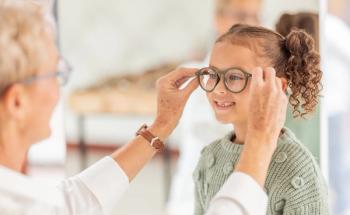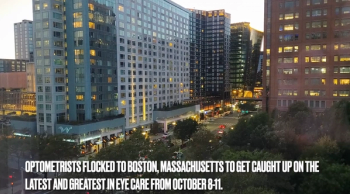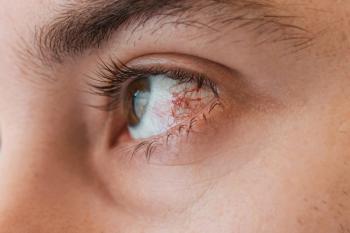
NOA 2023: Caring for and comanaging complex cases such as squamous cell carcinoma of the conjunctiva
Jacobi Cleaver, OD, FAAO, caught up with Optometry Times to talk about his presentation on squamous cell carcinoma of the conjunctiva, which he discussed at the National Optometric Association in Fort Lauderdale, Florida.
Jacobi Cleaver, OD, FAAO, from Baylor College of Medicine, caught up with Optometry Times®' assistant managing editor Emily Kaiser, to discuss his talk, "Squamous cell carcinoma of the conjunctiva," which he presented during the 2023 National Optometric Association convention in Fort Lauderdale, Florida.
Video Transcript
Editor's note: This transcript has been lightly edited for clarity.
Emily Kaiser:
Hi, everyone. I'm Emily Kaiser with Optometry Times and I'm sitting down with Dr. Jacobi Cleaver, who is presenting a course called, "Squamous cell carcinoma of the conjunctiva," at the National Optometric Association 2023 annual convention in Fort Lauderdale, Florida. Welcome, Dr. Cleaver.
Jacobi Cleaver, OD, FAAO:
Thanks for having me.
Kaiser:
Can you tell us a little bit more about the course?
Cleaver:
Yeah, so squamous cell carcinoma of the conjuctiva is a pretty unique course because it's not extremely prevalent, but I don't want to say that it's extremely rare, either.
I work in a community clinic, so each section is separated by a pod, and so one of the nurses that I work closely with in another section came by and said, "Dr. Cleaver, do you want to see a patient? He's got something funky going on." And I said, "Yeah, sure."
So [the patient] comes in with a friend, and he is wearing a reflective vest...they do lawn care; this their job, they're out in the sun and everything all day every day. The patient's friend was speaking on behalf of the patient—we have a large Latino population here, and this was before I could get to the translation [inaudible]. And he said, "I would like for you to take a look at my friend here."
His friend is wearing sunglasses, he takes off his sunglasses, and [I see] the biggest mass on the front surface of of his eye. Just looking at ...this isn't probably gonna fare very well as far as prognosis. But getting him taken care of, getting him to where he needed to go as far as to be treated, this is a real opportunity here to really dive deep into squamous cell carcinoma. But that's the that's the invasive piece of it.
What about the noninvasive squamous cell ocular neoplasia? So we dive deep into that. So because there's specific entities, but you have todiscuss one in order to get to the other—that's the main purpose of this of this talk.
What I would like for optometrists to get from this, especially with the emergence of anterior segment OCT imaging, is not that we will be the ones treating this, but maybe we'll be the ones identifying this. Because this allows for a noninvasive approach with the imaging and everything else. And the imaging is so good now, you can almost interpret it just from looking at it. You want to look at specific details and characteristics of each particular lesion. And if you need to decide, is it this lesion versus that lesion, the OCT is a good [noninvasive] way to do that.
We don't have to get to the point of doing biopsies or anything like that. Of course, if that's needed, then we can refer to our colleagues in order to do that, but if you can refer to your colleagues and say, "I'm kind of thinking this; I'd like to hand it out to you," then that bodes well when you're making a referral.
Because that's the whole purpose of eye care—what I can't take care of, I want to be able to send it to someone who can, but I want you to know exactly what I'm thinking to see if we're on the same page.
I still see the patient about every 3 months here [and there]—not for anything related to the squamous cell carcinoma, but I still see him about every 3 months. I'm following him for diabetes and everything else. I just saw him about a month ago, he's doing fantastic.
So, it's a fun, it's a fun case, and I want to let optometrists know that sometimes they don't always have a happy ending. Sometimes the treatment needs to be what the treatment needs to be in order to help the patient and have the patient thrive and flourish.
I don't want to give away too much; I want you guys to come to the talk, because I think everyone will really enjoy it and love it and be able to take something away from him. Even if it's not as an extreme case...
Kaiser:
Absolutely, that's a key element of eye care is helping reroute patients to where they need to go. Do you have any specific key takeaway points?
Cleaver:
Surgery used to be the go-to management for these things, but surgeries of any kind is pretty invasive. Now with the emergence of topical medications, it offers a real opportunity to be on the forefront of these things.
Of course, depending on what state that you're in, not that we'll be the ones treating cancer, specifically in Texas, like I'm not allowed to treat cancer. But again, these are some some of the discussions I can have with my patient, or at least with the referring provider: Do you think the patient is a good candidate for this? Do you think the patient is a better candidate for that? Just open up the lines communications and working together.
Kaiser:
Yeah, absolutely. It's a key part of the process: to kick-start the treatment, catching it; diagnosis is the first step.
Cleaver:
I think, when you when you're looking at these, trying to differentiate between the lesions of is it benign, or noninvasive versus invasive, start with the history. Start with getting the patient history.
I remember one of my professors in school said, "you take the history from the beginning of the exam to the end of the exam until you get the history all the way through. I'm making a point that expresses, "What kind of work do you do? What do you have any family history of? Do you smoke? Do you do you engage in anything else?" We can't be afraid to ask these questions, because I would want someone to ask these questions of me if they're trying to get to a solution.
That's the whole purpose of the talk. Get the history, dive deep, and even if you don't know exactly what it is maybe form different options in your head and then just kind of go from there. The [ophthalmologists] that I work with are very appreciative of that; it's always just as easy as picking up a phone. But that's the whole purpose of the talk: practical. Let's look at it, is it this, is it that, let's form a treatment plan—even if we won't be the ones treating it—and go from there.
Kaiser:
Alright, well, thank you so much for taking the time to chat and I can't wait to see you in Florida.
Cleaver:
Looking forward to it.
Newsletter
Want more insights like this? Subscribe to Optometry Times and get clinical pearls and practice tips delivered straight to your inbox.



















































.png)


